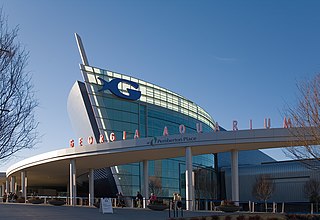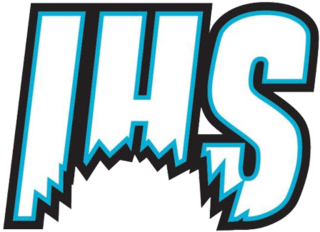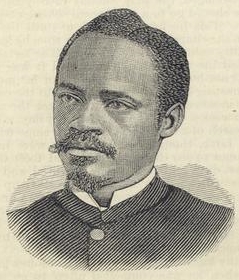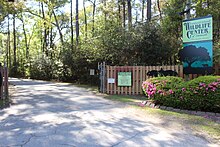
Savannah is the oldest city in the U.S. state of Georgia and the county seat of Chatham County. Established in 1733 on the Savannah River, the city of Savannah became the British colonial capital of the Province of Georgia and later the first state capital of Georgia. A strategic port city in the American Revolution and during the American Civil War, Savannah is today an industrial center and an important Atlantic seaport. It is Georgia's fifth most populous city, with a 2020 U.S. census population of 147,780. The Savannah metropolitan area, Georgia's third-largest, had a 2020 population of 404,798.

Georgia Aquarium is a public aquarium in Atlanta, Georgia, United States. The aquarium exhibits hundreds of species and thousands of animals across its seven major galleries, all of which reside in more than 11 million US gallons (42,000 m3) of water. It was the largest aquarium in the world from its opening in 2005 until 2012 when it was surpassed by the S.E.A. Aquarium in Singapore and the Chimelong Ocean Kingdom in China; the Georgia Aquarium remains the largest aquarium in the United States and the sixth largest in the world.

George Dekle Busbee Sr., was an American politician who served as the 77th governor of Georgia from 1975 to 1983.

Mercer University is a private research university with its main campus in Macon, Georgia. Founded in 1833 as Mercer Institute and gaining university status in 1837, it is the oldest private university in the state and enrolls more than 9,000 students in 12 colleges and schools. Mercer is a member of the Georgia Research Alliance. It is classified as a "R2: Doctoral Universities — High research activity".

Savannah Arts Academy (SAA) is the first dedicated performing and visual arts school in Savannah, Georgia, United States. It is part of the Savannah-Chatham County Public Schools. Savannah Arts Academy was granted charter school status and the former Savannah High School building in July 1998, and opened in August of the same year with 397 students enrolled.
The 1899 Georgia Bulldogs football team represented the University of Georgia during the 1899 Southern Intercollegiate Athletic Association football season. The team competed as a member of the Southern Intercollegiate Athletic Association (SIAA) and completed the season with a disappointing 2–3–1 record. However, a season highlight was the third-straight victory over Georgia Tech. 1899 also saw the first meeting between the Georgia Bulldogs and Tennessee. This was the team's first and only season under the guidance of head coach Gordon Saussy.
The 1906 Georgia Bulldogs football team represented the University of Georgia during the 1906 Southern Intercollegiate Athletic Association football season. The Bulldogs completed the season with a 2–4–1 record. Georgia’'s only victories came against Mercer and Auburn. The season included Georgia's third straight loss to Georgia Tech and the seventh straight loss to Clemson. During the 1906 season, the forward pass was legalized and the team tried to use this new play, however, an errant pass contributed to the loss to Davidson. This was the Georgia Bulldogs' first season under the guidance of head coach George S. Whitney.

In epidemiology, a disease vector is any living agent that carries and transmits an infectious pathogen such as a parasite or microbe, to another living organism. Agents regarded as vectors are mostly blood-sucking insects such as mosquitoes. The first major discovery of a disease vector came from Ronald Ross in 1897, who discovered the malaria pathogen when he dissected the stomach tissue of a mosquito.

The Savannah-Chatham County Public School System (SCCPSS) is a public school district in Chatham County, Georgia, United States. SCCPSS is run by an elected Board of Public Education and operates most all of the public schools in Chatham County, including those in the city of Savannah. It is the sole public school district in the county. The current superintendent is S. Denise Watts, Ed.D.
In the United States, the National Malaria Eradication Program (NMEP) was launched in July 1947. By 1951 this federal program—with state and local participation—had reduced the incidence of malaria in the United States to the point that the program was officially ended.

Chehaw Park is a park and zoo located in Albany, Georgia. The park was originally opened as Chehaw State Park in 1937, and currently covers 800 acres (320 ha). The Wild Animal Park was designed by naturalist Jim Fowler of television's Wild Kingdom. Fowler is originally from Albany, Georgia. It was opened in 1997, and features boardwalks in the cypress swamps that take visitors through natural habitat exhibits.

Noah's Ark Animal Sanctuary is a 501(c)(3) nonprofit American domestic, wildlife, and exotic animal rescue and rehabilitation center. It is located on 250 acres in Locust Grove, Georgia and houses over 1,500 animals. Many of the center's animals were rescued from unlicensed owners, donated by circuses and zoos, or surrendered by individuals who were either unable to provide the proper care or did not want them.

Islands High School is a public high school located on Whitemarsh Island in unincorporated Chatham County, Georgia, United States, east of Savannah. The school is part of the Savannah-Chatham County Public Schools, and its basic attendance zone covers the urbanized Georgia barrier islands of Whitemarsh, Wilmington, Talahi, and Tybee. The school is accredited by the Southern Association of Colleges and Schools and the Georgia Accrediting Commission. It is also home to the Savannah-Chatham school district's Scientific Research and Veterinary Science Specialty Programming.

The 1906 Georgia Tech Yellow Jackets football team represented the Georgia Institute of Technology during the 1906 Southern Intercollegiate Athletic Association football season. In the third season under coach John Heisman, Georgia Tech posted a 6–3–1 record.

Cannabis in Georgia is illegal for recreational use, but decriminalized in the cities of Atlanta, Savannah, Macon, Athens, and others. Limited medical use is allowed in the form of cannabis oil containing less than 5% THC.

Emanuel K. Love was a minister and leader in the Baptist church from Savannah, Georgia. He was pastor of one of the largest churches in the country and was a prominent activist for black civil rights and anti-lynching laws. He played an important role in establishing separate black Baptist national organizations and advocating for black leadership of Baptist institutions, especially schools.

Jefferson Street is a prominent street in Savannah, Georgia, United States. Located between Montgomery Street to the west and Barnard Street to the east, it runs for about 2 miles (3.2 km) from West Bay Street in the north to West 42nd Street in the south. Its course was interrupted by around 0.14 miles (0.23 km) by the construction of the Savannah Civic Center in 1974. The street is named for Thomas Jefferson, third president of the United States. Its northern section passes through the Savannah Historic District, a National Historic Landmark District.
Peter Roe Nugent was an American politician who served as mayor of Savannah, Georgia and as vice-chairman and pioneer member of the Georgia Ports Authority.

The Massie School, also referred to as the Massie Common School, opened in 1856 as the first public school in Savannah, Georgia, in the first chartered public school system of the American South. Located on Savannah's Taylor Square at 201–213 East Gordon Street, the original schoolhouse began construction in 1855 with invested funds from Peter Massie, an immigrant from Scotland. Massie intended his investment to be used for the creation of a free school for Savannah's poor children. The Massie School remained in use as a public elementary school until its closing in 1974; two notable exceptions include its utilization by Union troops as a hospital during the American Civil War and then briefly as a Freedmen's school. Today, the Massie Heritage Center occupies the original schoolhouse and serves as a museum. However, the building remains the longest continuously operating public schoolhouse in the state of Georgia.
Jean Rawlings Sumner is an American internist and academic administrator specialized in rural health. She has served as the dean of the Mercer University School of Medicine since 2016. Sumner is a past president of the Georgia Board of Medicine.
















